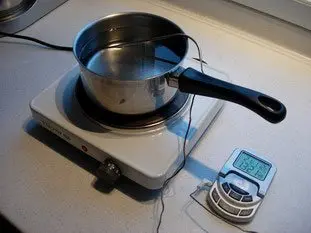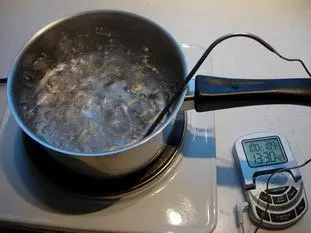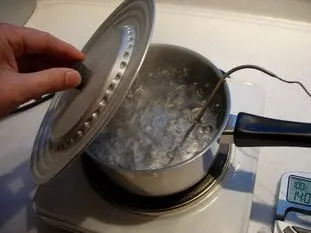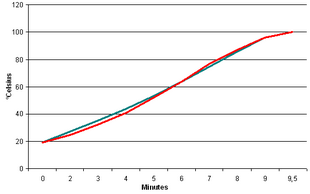This site uses only a few technical cookies necessary for its operation. By continuing to browse, you accept their use.
To find out more...
To find out more...
One should cover a pan while heating?
The legend
You should always cover a pot of water you want to boil, so that it boils faster.In other words, if you're heating water (or anything else), boiling is achieved more quickly if the pan is covered than if it's not.
How to check?
Boil 1 liter of water in a covered pan, timing the time, then 1 liter of water in an uncovered pan, again timing the time.Comparing the times will show whether you really need to cover the pot to go faster.
Let's check:
 We measure 1 liter of water and place it in an uncovered saucepan on a hotplate, into which we dip a thermometer.
We measure 1 liter of water and place it in an uncovered saucepan on a hotplate, into which we dip a thermometer.
 Turn on the stove and start the timer, reaching 100°C (210°F) in 9 minutes and 30 seconds.
Turn on the stove and start the timer, reaching 100°C (210°F) in 9 minutes and 30 seconds.The stove is left to cool down for about an hour, returning to room temperature.
 Another 1 liter of water is measured and placed in a covered saucepan on the stove, still using a thermometer.
Another 1 liter of water is measured and placed in a covered saucepan on the stove, still using a thermometer. Turn on the stove and start the stopwatch, reaching 100°C (210°F) in 9 minutes and 27 seconds.
Turn on the stove and start the stopwatch, reaching 100°C (210°F) in 9 minutes and 27 seconds. The result is even more obvious if you compare the temperature curve, with the uncovered pan in red and the covered pan in green.
The result is even more obvious if you compare the temperature curve, with the uncovered pan in red and the covered pan in green.Conclusion
The time difference is too small to be significant: covered or uncovered, it's practically the same thing.Some people have pointed out to me that if we were using a (much) larger volume of water, it wouldn't be the same; the lid would be effective, but in home cooking, we only use small volumes.
To sum up:"You should always cover a pot of water you want to boil, so that it boils faster", is not true.
Lasts posts
Butter vs. grease
We often read in a recipe where a pastry is put into a mould that, just before pouring, the mould should be buttered or greased. But what's the difference between these 2 terms?December 1st 20257615
Getting out of the fridge early
Very often when you're cooking, you need to take food or preparations out of the fridge, to use them in the recipe in progress. There's nothing tricky about this: you just take them out of the fridge and use them, usually immediately, in the recipe. But is this really a good method?November 24th 20251,0005
Who's making the croissants?
When you look at a bakery from the outside, you naturally think that in the bakery, the bakers make the bread, and in the laboratory, the pastry chefs make the cakes. It's very often like that, with each of these professions having quite different ways of working, but sometimes there's also one...November 23th 2025899
Oven height
When we put a dish or cake in the oven, we naturally tend to put it on the middle shelf, and that's what we usually do. But in some cases, this position and height can be a little tricky, so let's find out why.October 8th 20252,5215
The importance of sieving
In recipes that use a fine powder (flour, powdered sugar, etc.), you'll often see the advice to sift before using it. To sift is to pass the powder in question through a sieve (a very fine strainer) before incorporating it into your recipe. It's often advice, but is it really useful?September 3rd 20257,3893
Other pages you may also like
Drawing a pattern in pastry
Often in the kitchen, in pastry-making, or in baking, we need to trace a pattern on a pastry. It's just a question of aesthetics but it has its effect after baking on a galette, pithiviers, pâté en croute (terrine in a pie crust), etc.May 23th 201935 K4.1
Egg yolks and caster sugar
We often come across recipes where we need to mix egg yolks with caster sugar. This would appear to be a very ordinary and simple thing to do but, be warned, these two ingredients can behave oddly together.February 15th 201882 K 24.3
Baking cakes
Where we see that to put a cake in the oven, once the dough is finished and in its mould, there is no hurry and that the cold is your friend.June 28th 201945 K4.1
Your oven in "proofer" mode
In the bakery, proofing is a crucial stage in the process of making light, plump breads and pastries. During proofing, the yeast ferments the sugars present in the dough, releasing carbon dioxide which forms bubbles. This process allows the dough to swell and aerate, guaranteeing a soft, light...September 27th 202410 K5
The window-pane test in bread-making
The home bread-makers often ask themselves “Have I kneaded my dough long enough?” . A good question, as dough that is insufficiently kneaded will not rise properly or will fall flat when the top is slashed, which is very frustrating. To know when the dough is ready, one can rely on the length...June 16th 202196 K 23.9
Follow this page
If you are interested in this page, you can "follow" it, by entering your email address here. You will then receive a notification immediately each time the page is modified or a new comment is added. Please note that you will need to confirm this following.
Note: We'll never share your e-mail address with anyone else.
Alternatively: you can subscribe to the mailing list of cooling-ez.com , you will receive a e-mail for each new recipe published on the site.










The 1 comment already posted on this page